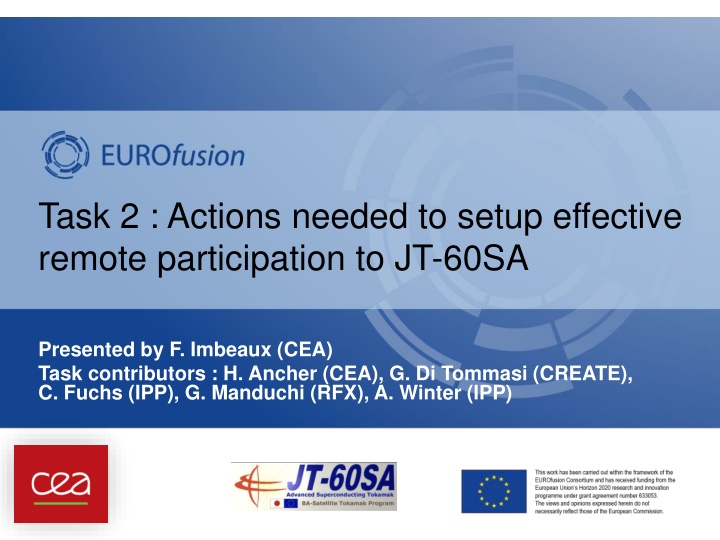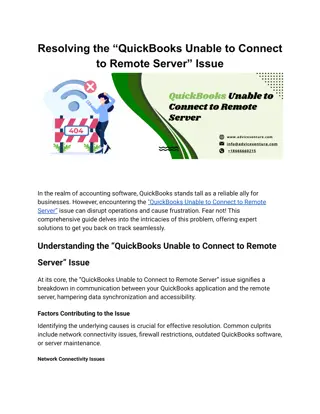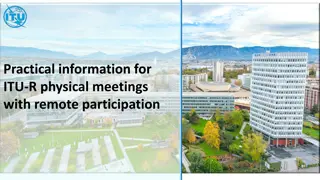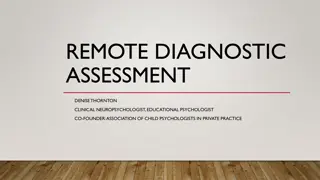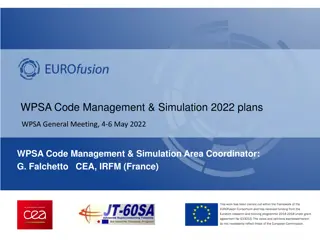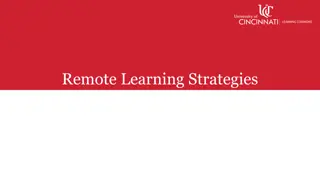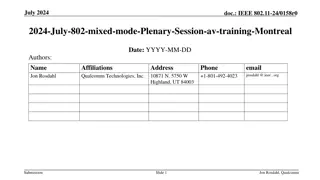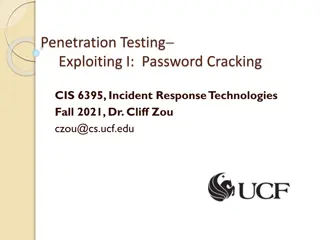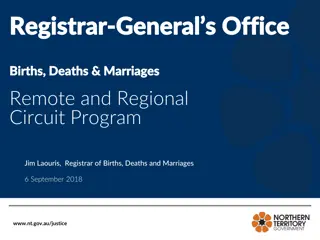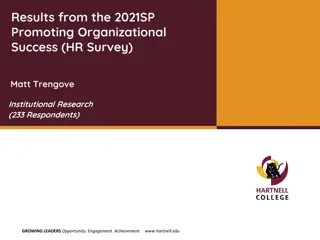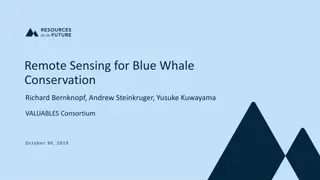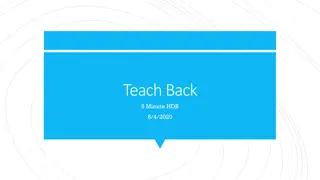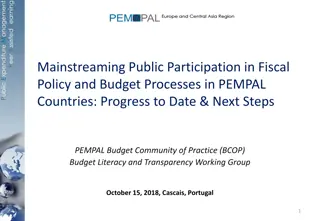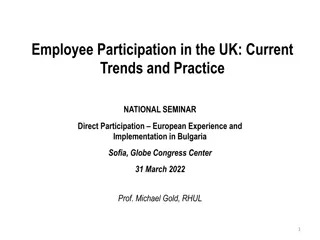Setting Up Effective Remote Participation for JT-60SA
This task involves providing a status update on actions related to remote participation, including policy and technical aspects, based on the 2018 WPSA reports. Progress has been made in drafting a deliverable report and recommendations. Further investigations and recommendations are outlined to enhance remote data access, live remote participation processes, IT support, and collaborative tool development for the JT-60SA project.
Download Presentation

Please find below an Image/Link to download the presentation.
The content on the website is provided AS IS for your information and personal use only. It may not be sold, licensed, or shared on other websites without obtaining consent from the author.If you encounter any issues during the download, it is possible that the publisher has removed the file from their server.
You are allowed to download the files provided on this website for personal or commercial use, subject to the condition that they are used lawfully. All files are the property of their respective owners.
The content on the website is provided AS IS for your information and personal use only. It may not be sold, licensed, or shared on other websites without obtaining consent from the author.
E N D
Presentation Transcript
Task 2 : Actions needed to setup effective remote participation to JT-60SA Presented by F. Imbeaux (CEA) Task contributors : H. Ancher (CEA), G. Di Tommasi (CREATE), C. Fuchs (IPP), G. Manduchi (RFX), A. Winter (IPP)
Task : provide a status update on the actions related to remote participation (policy and technical aspects) Systematic analysis of the status of the actions recommended in the 2018 WPSA reports: Establishing a development plan for the EU remote experiment centre (WPSA report EFDA_D_2NJLES) Technical requirements for EU remote control room (WPSA report EFDA_D_2N39XB) Including checking how La Bergerie fulfills the criteria for the EU-Remote Experiment Centre Facilitate data access by creating an IMAS interface to JT-60SA data F. Imbeaux | WPSA Meeting | 6 September 2022 | Page 2
Task progress : deliverable report drafted, about 20 pages so far Systematic analysis of the status of the actions recommended in the 2018 WPSA reports. Done, drafting recommendations for future actions Including checking how La Bergerie fulfills the criteria for the EU-Remote Experiment Centre. Done, drafting main conclusions Facilitate data access by creating an IMAS interface to JT-60SA data. Not done, to be prototyped when we get access ! F. Imbeaux | WPSA Meeting | 6 September 2022 | Page 3
Part 1 recommendations : open points to be further investigated to prepare an efficient remote participation Policy of remote data access for EU-researchers after the IC Phase (who can get access, when and under which conditions ?) the present policy being too restrictive and the process too slow to achieve a wide EU remote participation Policy and processes for live remote participation to experiments from EU : define organization, communication model, role of the remote team in the control room organization (w.r.t. the on-site team) Tools and procedures for Plasma Processing Chain, Data Validation, should be discussed and agreed IT support : so far relies on a single contact person, we recommend putting in place a proper IT helpdesk service (with a ticketing system, such as e.g. Jira) The amount of JT-60SA documentation available in English is still very limited, but we are confident that it will expand as EU users request more information So far, the official JT-60SA documentation is completely controlled by QST. How to capitalize collectively the development of the analysis tools and their documentation ? Risk that each user re-develops its own version of the same tool Tools : Data access (WebAPI) and Discharge Editor (HMI) tools are cumbersome. Prototype IMAS data access and wait for new versions of the tools (HMI) Computing resources for experimental analyses: the QST VPN prevents from logging to an external server, meaning all computations have to be done on the Naka server (will this scale ?), or need to make local copy of the data before transferring it another server (the EUROfusion Gateway ?). F. Imbeaux | WPSA Meeting | 6 September 2022 | Page 4
A REC facility has been built at Cadarache in the framework of the Broader Approach La Bergerie Dedicated building at the Cadarache Castle site (near ITER) Restaurant and hotel on site Connection to RENATER Experiment room for ~18 people Meeting room, kitchen, New immersive software for remote participation Imminent tests during WEST C6 F. Imbeaux | WPSA Meeting | 6 September 2022 | Page 5
Part 2 conclusions: qualitatively, La Bergerie is already compliant with most of the requirements issued in 2018 Systematic compliance analysis of La Bergerie (in its present state) w.r.t. to the EU-REC requirements listed in the 2018 report Qualitatively, La Bergerie is already compliant with most of the requirements issued in 2018, including those of the Phase 2 EU- REC . The setup of La Bergerie is designed to host comfortably about 18 people and offer them the required network, computer terminals, video walls, remote experiment room, meeting room and lounge. The main differences with the requirements issued in 2018 are: The 2018 EU-REC scenario described multiple remote experiment rooms across Europe, connected by a specific network. Presently, a single Remote Experiment Room is provided, in Cadarache The 2018 EU-REC scenario assumed that computing and mass storage facilities would be dedicated to JT-60SA remote participation. Presently, La Bergerie doesn t include those, although there are possibilities to buy them if funded by EUROfusion. However we note that i) the way to use a local EU mass storage facility for JT-60SA would need to be defined and agreed with the Japanese side and ii) it may be more efficient to rely on other joint EUROfusion computing ressources (e.g. the Gateway) instead of dedicating computing resources specifically to the JT-60SA participation. Quantitatively, the number of persons present at EU-REC at a given time is between 20 and 30 in the 2018 reports, while the present La Bergerie capability is rather of ~18 persons. However, this does not prevent from starting to use the facility and see if we hit this limit (which would be a marker of success by the way!) F. Imbeaux | WPSA Meeting | 6 September 2022 | Page 6
Part 2 conclusions: La Bergerie could be used to validate the Grant deliverable about the EU-REC Grant deliverable SA.D.05, due in January 2023 : Delivery and final tests of the EU-REC completed La Bergerie could be used to validate the Grant deliverable about the EU-REC, with the reservations explained on the previous slide What tests could be done by January 2023 ? Following JET experimental sessions was already tested in December 2022, but the persons present in La Bergerie at the time had no active role in the experiment Tests with WEST will be carried out this automn Participation to WPTE experiments in other device (JET, TCV, MAST?) are likely Possibility of organizing something with JT-60SA this automn ? Watching the first plasma from La Bergerie ? IRFM can organize these tests, but other participants are welcome F. Imbeaux | WPSA Meeting | 6 September 2022 | Page 7
Perspectives Open points for remote participation : we recommend starting discussing these points before the end of 2022, since they are key to achieve an efficient participation of the EU researchers to the analysis of the results of the IC phase and of the first plasmas that should occur in 2023 La Bergerie could be used to validate the Grant deliverable about the EU-REC (recall the requirement here ...) define and carry out the final tests Facilitate data access by prototyping an IMAS interface to JT-60SA data F. Imbeaux | WPSA Meeting | 6 September 2022 | Page 8
